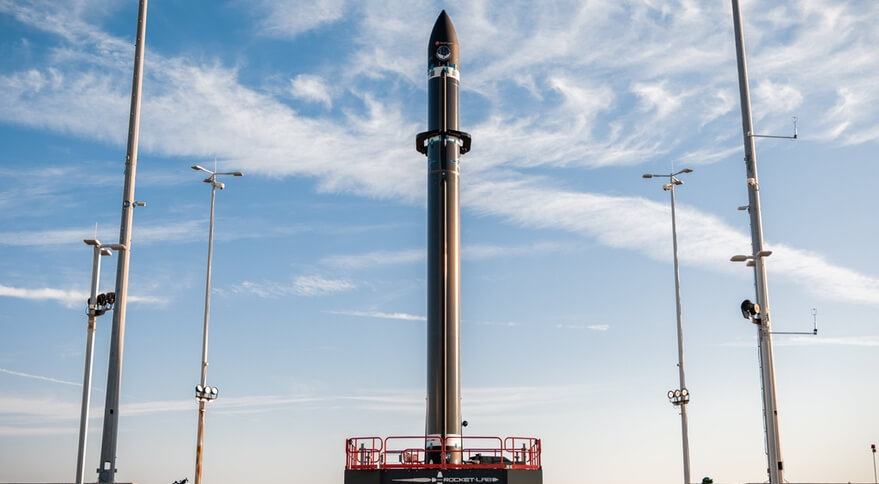WASHINGTON — After more than two years of delays, NASA and Rocket Lab are finally ready to conduct the first Electron launch from Wallops Island in Virginia on Dec. 16.
The launch, called “Virginia is for Launch Lovers” by the company, is scheduled from the company’s Launch Complex (LC) 2 at the Mid-Atlantic Regional Spaceport at Wallops during a two-hour window that opens at 6 p.m. Eastern Dec. 16. There is an 85% chance of favorable weather for the launch that day as well as on a backup day Dec. 17.
The mission will place into orbit three satellites for HawkEye 360, which operates a constellation of spacecraft that perform radio-frequency surveillance. HawkEye 360 signed a contract in April for three Electron launches, including the first Electron launch from Wallops.
The scheduled launch comes three years after Rocket Lab declared Launch Complex 2 complete. At that time, it expected to perform the first launch there in the second quarter of 2020 for the Defense Department’s Space Test Program. However, delays in development by NASA of a new autonomous flight termination system (AFTS) required for Electron launches from Wallops delayed that first flight by more than two years.
At a Dec. 14 online briefing, David Pierce, director of NASA’s Wallops Flight Facility, said the final safety certification of what’s called the NASA Autonomous Flight Termination Unit (NAFTU) was originally scheduled in time to support a mid-2020 first launch from LC-2. During final checks of the software, engineers discovered numerous errors in the code.
In the fall of 2020, NASA established a “cross-agency” team that included the U.S. Space Force and Federal Aviation Administration to fix the software and go through a certification process, he said. It took more than a year to develop the test procedures and scripts needed to ensure the software met range safety requirements.
By early 2022, NAFTU was ready for independent certification testing. “As part of that, as normally happens in I&T [integration and testing], you find errors or bugs that needed to be fixed, and that’s what we did,” he said. “We knocked down each one of those challenges, one by one, and we completed independent testing in the summer of 2022.”
The system completed an independent certification led by the chief engineer of NASA’s Goddard Space Flight Center in October. “As soon as we completed that, we turned to supporting Peter [Beck] and the fabulous Rocket Lab team” as the company modified NAFTU for use on Electron.
Rocket Lab’s implementation of NAFTU, which the company calls Pegasus, has received approval from the FAA for the upcoming launch. Pierce said NASA still needs to complete “cleaning up some of the paperwork” for full certification of NAFTU from the FAA, which he expects to be complete by the end of the month.
He said there is some additional final paperwork to complete for the Electron launch, in the form of additional analyses by a joint NASA-Rocket Lab team. “What we’ve been doing over the past couple weeks is following up with answers to questions to show how NASA Wallops validated the combined response to our flight safety plan to the FAA,” he said. That work will be complete before a Dec. 15 launch readiness review.
NAFTU will be available to other range users to reduce the number and cost of traditional range safety assets and support higher flight rates. Eighteen companies have requested access to the software, Pierce said, but Rocket Lab will be the first to use it on the upcoming Electron launch.
Rocket Lab has been using its own AFTS for more than 20 Electron launches from its original launch site, LC-1 in New Zealand. “It is a significant reduction in range costs and range equipment,” Beck, chief executive of Rocket Lab, said at the briefing. “AFTS is a huge game-changer.”
A successful launch would finally bring into service LC-2, which Beck said will enable the company to increase its launch rate, of about one per month for most of 2022, in 2023. He offered few specifics about upcoming launches from Wallops at the briefing, but in an earnings call Nov. 9 executives said they anticipated performing 14 Electron launches in 2023, four to six of which would be at LC-2.
Most customers will be able to use either LC-1 or LC-2, he said, and can move between them. “There are some customers that have a U.S. launch requirement,” primarily U.S. government agencies, he said, requiring them to use LC-2.
Beck said the company set up in Virginia, rather than at Cape Canaveral Space Force Station or Kennedy Space Center in Florida, because of the “quietness of the range” or lack of other launches from Wallops. The site currently hosts two Northrop Grumman Antares launches a year along with an occasional Minotaur launch by that company, as well as about a dozen sounding rocket launches a year.
“KSC is an amazing range, but I think everybody has to agree it’s pretty busy,” he said. The company also plans to use Wallops for its Neutron reusable launch vehicle, which will be produced at a factory just outside the Wallops gates. “We can achieve almost the same trajectories out of Virginia and the range is not nearly as busy. There’s a lot of room to grow.”

